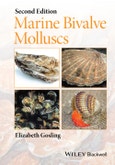Marine Bivalve Molluscs is a comprehensive and thoroughly updated second edition of Bivalve Molluscs, covering all major aspects of this important class of invertebrates. As well as being an important class biologically and ecologically, many of the bivalves are fished and cultured commercially (e.g. mussels, oysters, scallops and clams) in a multi-billion dollar worldwide industry.
Elizabeth Gosling has written a landmark book that will stand for many years as the standard work on the subject. Chapters in Marine Bivalve Molluscs cover morphology, ecology, feeding, reproduction, settlement and recruitment, growth, physiology, fisheries, aquaculture, genetics, diseases and parasites, and public health issues. A full understanding of many of these aspects is vital for all those working in bivalve fisheries and culture.
An essential purchase for anyone concerned with this important class of animals, copies of Marine Bivalve Molluscs should be on the shelves of biologists, ecologists, environmental scientists, fisheries scientists and personnel within the aquaculture industry. Copies of the book should be available in all libraries and research establishments where these subjects are studied or taught.
Reviews of the First Edition
- An admirable achievement... a valuable addition to marine sciences libraries everywhere. The back cover of this book says that it is a landmark text that will stand for many years as the standard work on this subject. I can only agree with this sentiment. Aquaculture
- A welcome addition to the literature and provides the reader with a comprehensive overview of biological and environmental factors that affect and control both natural populations of marine bivalves and culture operations. Aquaculture International
- The author has done an admirable job in compiling a wealth of information into a readable text. Transactions of the American Fisheries Society
- Will serve well as a description of much of both the experimental biology and the aquaculture of bivalves. Journal of Experimental Marine Biology and Ecology
- Provides excellent reviews of all major aspects…an extremely important reference for anyone engaged in bivalve research, fisheries management, and aquaculture. Quarterly Review of Biology
- The book is very readable, in an easy style. It is well illustrated and there is a wealth of data and statistics presented. Bulletin of The Malacological Society of London
Table of Contents
Preface viii
Acknowledgements x
1 Phylogeny and evolution of bivalve molluscs 1
Phylogeny of the Mollusca 1
Phylogeny and evolution of Bivalvia 3
Evolution and adaptive radiation in Bivalvia 7
Notes 10
References 10
2 Morphology of bivalves 12
Introduction 12
Shell 12
Mantle 21
Gills 24
The foot 27
Labial palps and alimentary canal 31
Gonads 34
Heart and haemolymph vessels 34
Excretory organs 35
Nerves and sensory receptors 36
References 38
3 Ecology of bivalves 44
Introduction 44
Global and local distribution patterns 44
Factors affecting geographic distribution 52
Factors affecting local distribution 55
Climate change 78
Note 84
References 84
4 How bivalves feed 99
Introduction 99
Filtration rate 100
Particle processing on the gills, labial palps and in the stomach 110
The alimentary canal and digestive process 128
Absorption efficiency 139
Effects of bivalve suspensionÂ]feeders on the ecosystem 141
Notes 144
References 144
5 Reproduction, settlement and recruitment 157
Introduction 157
Sexuality 157
Gametogenesis 159
Reproductive cycles 159
Factors controlling reproduction 165
Annual storage cycle 170
Reproductive effort and fecundity 171
Deleterious effects on the reproductive cycle 175
Fertilization 175
Larval development 177
Factors affecting larval growth 178
Larval dispersal and population connectivity 181
Larval identification and abundance estimation 184
Settlement, metamorphosis and postÂ]larval dispersal 185
References 189
6 Growth 203
Introduction 203
Methods of measuring absolute growth 203
Allometric growth 213
Scope for growth and dynamic energy budget models 216
Factors affecting growth 219
Note 232
References 232
7 Circulation, respiration, excretion and osmoregulation 243
Circulation 243
Respiration 246
Excretion and osmoregulation 260
Note 264
References 264
8 Fisheries and management of natural populations 270
Introduction 270
Population dynamics 271
Total mortality (Z) 279
Natural mortality (M) 280
Fishing mortality (F) 281
Fisheries assessment and management 282
Scallop fisheries 287
Oyster fisheries 301
Mussel fisheries 309
Clam fisheries 314
References 319
9 Bivalve culture 325
Introduction 325
Fundamentals of bivalve culture 326
Mussel culture 340
Oyster culture 348
Scallop culture 355
Clam culture 362
Bivalve culture and the environment 369
Ecosystem approach to bivalve culture 371
Note 374
References 375
10 Genetics in aquaculture 383
Introduction 383
Quantitative genetics and selective breeding 384
Selective breeding 386
Protein and DNA markers 394
Bivalve genomics 403
Chromosomal genetics and ploidy manipulation 408
Transgenics 417
Notes 419
References 419
11 Diseases and parasites 429
Introduction 429
Viruses 429
Bacteria 431
Fungi 434
Protistans 434
Porifera 447
Helminths 448
Annelids 451
Crustaceans 452
Neoplasia 454
Defence mechanisms 455
Perspectives 463
References 464
12 Public health 478
Introduction 478
Bacterial infections 478
Viral infections 480
Biotoxins 481
Industrial pollutants 488
Controls on the production and processing of bivalves 490
Elimination of pathogens and other hazards 495
Monitoring and quality control 499
HAACP system 502
Notes 508
References 508
Subject index 000
Species index 000








